Cardamine concatenata
An ephemeral spring wildflower of moist woodlands
Cardamine concatenata cutleaf toothwort
Add to MyPlants View Locations
This native herbaceous, perennial member of the mustard family is a spring ephemeral wildflower in moist woodlands. The genus Cardamine includes the bittercress group of flowers. The cut-leaved toothwort is one of the four common species of toothwort that grow in the state about the same time. The plant grows 7 to 16 inches tall. It is a woodland species commonly growing in rich soil with significant leaf litter.
This species blooms before the leaves are out on the trees and after about two weeks goes to seed. After that the leaves wither and die back. This species has a cluster of white to pinkish fragrant flowers on a single stalk. Each flower is about ¾ inch long and opens fully on warm sunny days. The 4 petals are typical of the mustard family and are arranged in the shape of a cross when the flower is fully opened. Long-tongued bees are the major pollinators of this species, but other insects will visit the flowers for a nectar reward. The fruit is a thin elongated pod up to 4 cm long with a small beak at the end. The name toothwort refers to the root or rhizome that consists of a string of tooth-like segments.
The three deeply lobed stem leaf accounts for the first part of its common name. These leaves are in a whorl of three, partially up the stem. Basal leaves also arise directly from the rhizome, usually after flowering and are of similar form. The plant can spread by growth of the rhizome or by means of seed dispersal.
In various localities, this species is also called: lady's smock, crow’s toes, crinkleroot, milkmaids, pepperroot, pepperwort, and toothache root. It was a common belief that the shape of a plant was a sign of what human ailment that plant could cure. Native Americans did use mashed roots of this plant to treat toothaches. The leaves of the toothwort are edible and said to be tasty if boiled with a little salt. The medical treatments are unlikely and there are better sources of wild food than these leaves.
Cut-leaved toothwort is found throughout the eastern ⅔ of the United States, though it is more abundant in the northern part of that range, but is endangered in Maine and New Hampshire. It is found in all parts of the state (except most north).
Three other toothwort species of interest in our state are large toothwort (Cardamine maxima), two-leaved toothwort (Cardamine diphylla) and slender toothwort (Cardamine angustata). Large toothwort has 3 leaves that branch off the stem at different levels in alternating fashion rather than at the same level. Two-leaved toothwort has only a pair of stem leaves, rather than three and these are nearly opposite on the stem. The leaves are not as deeply cut as on the other species. The slender toothwort, has broad, long-stalked basal leaves, divided into 3 segments and stem leaves that are divided into three more slender toothed or toothless, lance-shaped segments.
Habitat & Range
Common in decidious woods. Prefers part shade and rich, moist, well-drained soil.
Present throughout the state, except northermost counties.
Range: From Quebec and Ontario down to Florida and Texas and westward to Kansas and Oklahoma.
| EMP: | FACU |
|---|---|
| NCNE: | FACU |
Phenology
Flowers late March through early May. Blooming lasts from 1 to 3 weeks.
Characteristics
Inflorescence terminal raceme; 3 to 12 flowers
Flowers perfect; 4 petals white or purplish, 0.4-0.8″ long; sepals green, oval, small; 6 yellow stames; ½ to ¾″ across
Leaves palmately compound with 3 leaflets; stalked
Cauline leaves 3 whorled or (occasionally) 2 opposite; leaflets stalkess, generally oblong-elliptic, medium to dark green, highly variable, large teeth or varying-size lobes along margins
Basal leaves arise directly from the rhizome, usually after flowering; similar shape as cauline ones
Stems slender, erect, rise directly from rhizome; smooth or slightly downy below, hairy above; 7-16″
Fruit dry, elongated seed pod; ascending; up 1½ inch long; with small beak at tip; seeds small, brown, round to oval in shape
Rhizome constricted at intervals (consists of a string of tooth-like segments)
Height 7-16″
Plant Codes
S-rank: S5 (Secure)
G-rank: G5 (Secure)
Ecology
Long-tongued bees are the primary pollinators and other insects will visit the flowers for nectar.
Deer and rabbits browse on leaves and stems.
Certain caterpillars and beetles feed on the foliage.
Cardamine concatenata cutleaf toothwort
Synonyms: Dentaria concatenata, Dentaria laciniataAdd to MyPlants View Locations
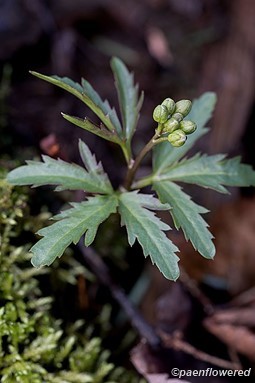
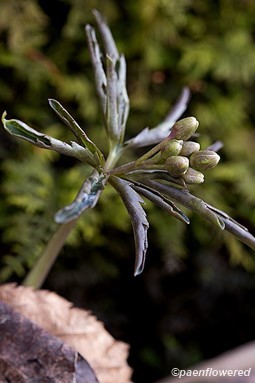

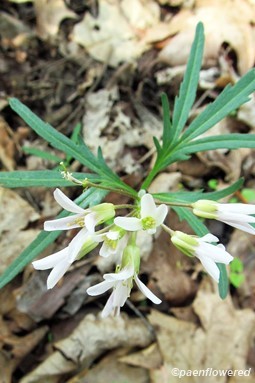
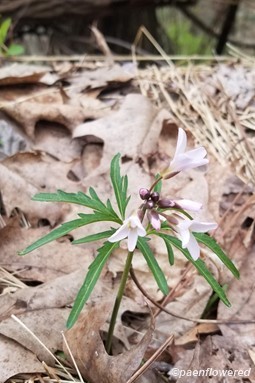
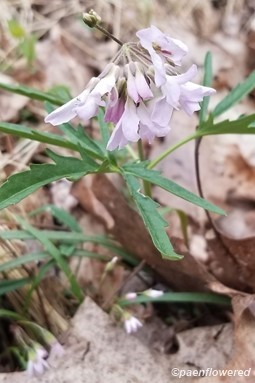
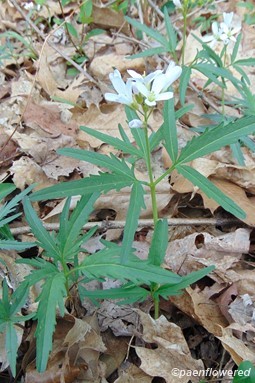
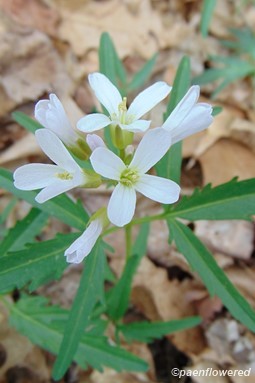
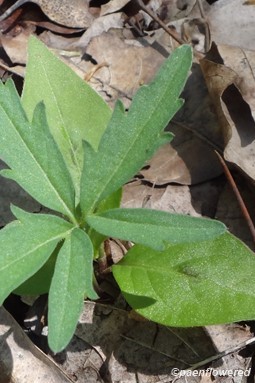










Comments
Have you spotted this plant in your area? We'd love to hear about your experience! Share your comments or questions about the plant below. Comments are moderated before posting.